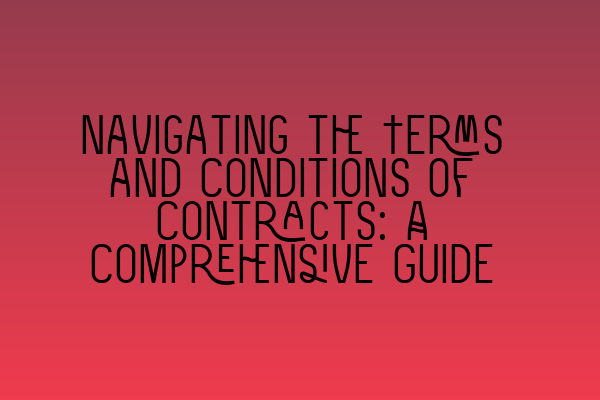Navigating the Terms and Conditions of Contracts: A Comprehensive Guide
In the world of business and law, contracts are the cornerstone of every commercial transaction. They form the basis of agreements between parties, outlining the rights and obligations of each party involved. However, the terms and conditions of contracts can often be complex and confusing, leaving many individuals feeling overwhelmed and unsure about what they are signing.
Whether you are a business owner, entrepreneur, or simply someone who frequently deals with contracts, understanding the intricacies of contract terms and conditions is essential. This comprehensive guide aims to shed light on the subject, providing you with valuable insights and practical tips to navigate the terms and conditions of contracts with confidence.
1. Importance of Contract Terms and Conditions
Before delving into the specifics, let’s first understand why contract terms and conditions are crucial. These provisions serve as the blueprint for the transaction, covering essential aspects such as payment terms, delivery schedules, dispute resolution mechanisms, and more. Clear and well-drafted terms and conditions can help protect your rights and interests, minimize legal disputes, and ensure smoother business dealings.
2. Elements of Contract Terms and Conditions
Contract terms and conditions typically comprise several key elements that provide clarity and establish the foundation of the agreement. These elements may include:
2.1 Definitions: Begin by clearly defining terms used throughout the contract to avoid confusion and ambiguity. Link to SQE 1 Practice Exam Questions for more information on contract terminology.
2.2 Parties: Clearly identify the parties involved in the contract. This includes their legal names, addresses, and contact details.
2.3 Scope of Work: Define the exact nature and extent of the work to be performed or the goods/services to be delivered.
2.4 Payment Terms: Specify the payment schedule, method, and currency to be used. Include details about invoicing, discounts, late payment penalties, and any other relevant financial provisions.
2.5 Delivery and Performance: Outline the conditions and timeframe within which the work or products must be delivered or provided.
2.6 Termination: Define the circumstances and procedures for terminating the contract, including any associated penalties or obligations.
2.7 Intellectual Property: Address ownership and usage rights of intellectual property created or used during the contract.
2.8 Confidentiality: Include provisions for protecting confidential information shared during the contract period.
2.9 Dispute Resolution: Specify the method and venue for resolving any disputes that may arise during the contract period. Incorporate alternative dispute resolution methods like arbitration or mediation, if applicable.
3. Drafting Clear and Precise Terms and Conditions
When drafting contract terms and conditions, it is essential to aim for clarity and precision to ensure that all parties understand their rights and obligations. Here are some key tips:
3.1 Use Plain Language: Avoid excessive legal jargon and use plain language to increase readability and comprehension.
3.2 Be Specific: Provide specific details and avoid ambiguity whenever possible. Link to SQE 1 Practice Mocks FLK1 FLK2 for practice in drafting precise provisions.
3.3 Be Comprehensive: Cover all necessary aspects and potential scenarios to minimize the chance of future conflicts.
3.4 Seek Legal Advice: Consulting with a contract law expert can help ensure that your terms and conditions are legally sound and enforceable. SQE Contract Law offers SQE 2 Preparation Courses to sharpen your legal drafting skills.
4. Reviewing and Negotiating Contract Terms and Conditions
Often, contracts involve negotiations between parties, where each side seeks to protect its interests. During the negotiation process, it is important to carefully review and analyze the terms and conditions proposed by the other party. Some key points to consider include:
4.1 Identifying Ambiguities: Look for any unclear or ambiguous provisions that may lead to confusion or give one party an unfair advantage.
4.2 Assessing Risk Allocation: Consider the allocation of risk between the parties and evaluate if it is reasonable and balanced. Identify clauses that might impose disproportionate liability on one party.
4.3 Understanding Legal Obligations: Ensure that you fully understand your legal obligations before agreeing to any terms and conditions. Seek SQE 1 Preparation Courses to strengthen your legal knowledge.
4.4 Negotiating Amendments: Propose and negotiate amendments to unfavorable terms if necessary. Remember that contract negotiation is a give-and-take process.
5. Seeking Professional Assistance
If you find yourself facing complex or unfamiliar contract terms, seeking professional assistance from a qualified contract law solicitor can provide you with the expertise and guidance needed to navigate and understand these provisions. SQE Contract Law offers legal services in contract drafting, review, negotiation, and amendment.
Understanding and navigating the terms and conditions of contracts is a critical skill for business success. By following the guidelines outlined in this comprehensive guide, you can arm yourself with the knowledge to protect your rights, minimize risks, and ensure successful and harmonious business dealings.
For more information on SQE exam dates and preparation courses, visit SRA SQE Exam Dates.
